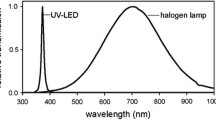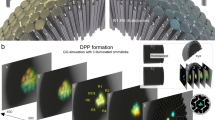Summary
If the living eye of Calliphora erythrocephala is illuminated “antidromically” (from behind) and viewed through a microscope of medium aperture, the rhabdomeres of each ommatidium within a large area can be seen simultaneously at a focal plane within the compound eye. The rhabdomeres appear in a virtual image, upright and magnified. They shift with time towards the cornea and the pseudopupil drifts to the side, becoming smaller. The reasons for this phenomenon remain unclear. Suggestions are made for its use. The effect was employed, for example, to show the pattern of the rhabdomere arrangement at the border between the dorsal and ventral parts of the eye.
Zusammenfassung
Betrachtet man mit einem Mikroskop mittlerer Apertur eine Bildebene im Komplexauge, so kann man bei antidromer Beleuchtung bei Calliphora erythrocephala am intakten Auge innerhalb eines größeren Bereichs gleichzeitig die Rhabdomere eines jeden Ommatidiums deutlich in Form eines virtuellen, aufrechten und vergrößerten Bildes sehen. Die Rhabdomere verschieben sich mit der Zeit distalwärts bei gleichzeitiger Verkleinerung und Wanderung der Pseudopupille. Die Ursachen der Erscheinung bleiben ungeklärt. Es werden Hinweise zur methodischen Ausnützung dieser Erscheinung gegeben; als Beispiel wird die Rhabdomerenanordnung an der Grenze zwischen dem dorsalen und ventralen Augenteil gezeigt.
Similar content being viewed by others
Literatur
Gurr, E.: Staining animal tissues practical and theoretical. London: Leonard Hill Ltd. 1962.
Kirschfeld, K., Franceschini, N.: Optische Eigenschaften der Ommatidien im Komplexauge von Musca. Kybernetik 5, 47–52 (1968).
Kirschfeld, K., Franceschini, N.: Ein Mechanismus zur Steuerung des Lichtflusses in den Rhabdomeren des Komplexauges von Musca. Kybernetik 6, 13–22 (1969).
Romeis, B.: Mikroskopische Technik. München: Oldenbourg 1968.
Seitz, G.: Der Strahlengang im Appositionsauge von Calliphora erythrocephala (Meig.). Z. vergl. Physiol. 59, 205–231 (1968).
Author information
Authors and Affiliations
Additional information
Die Arbeit wurde durch eine Sachbeihilfe der Deutschen Forschungsgemeinschaft an Herrn Prof. Dr. H. Autrum unterstützt.
Mit Unterstützung des Deutschen Akademischen Austauschdienstes.
Rights and permissions
About this article
Cite this article
Gemperlein, R., Järvilehto, M. Direkte Beobachtung der Rhabdomere bei Calliphora erythrocephala (Meig.). Z. Vergl. Physiol. 65, 445–454 (1969). https://doi.org/10.1007/BF00299053
Received:
Issue Date:
DOI: https://doi.org/10.1007/BF00299053




